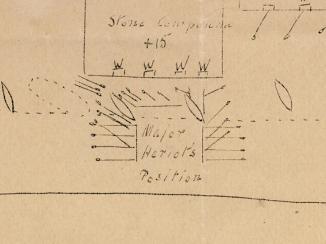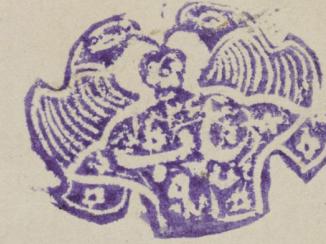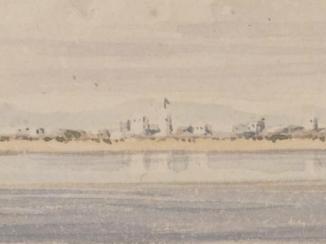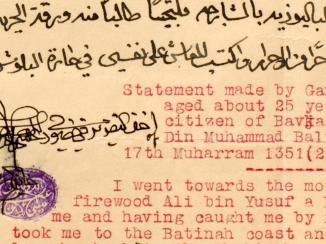'File 5/193 III (B 46) Slavery in the Persian Gulf'
IOR/R/15/1/227
497 items in this record
Search within this record
The record is made up of 1 volume (243 folios). It was created in 13 Jul 1936-4 Apr 1938. It was written in English. The original is part of the British Library: India Office The department of the British Government to which the Government of India reported between 1858 and 1947. The successor to the Court of Directors. Records and Private Papers Documents collected in a private capacity. .
About this record
- Content
The volume contains confidential correspondence related to the slave trade and slavery, exchanged between a number of British Government representatives. It should be read in conjunction with IOR/R/15/1/226, of which this file is a continuation, there being numerous references to it in some of the correspondence in this volume (for example, on folios 18-19, and 20).
A large proportion of the correspondence is high-level, relating to requests from the British Government and the League of Nations for information on the nature and extent of slavery and the slave trade in the Persian Gulf The historical term used to describe the body of water between the Arabian Peninsula and Iran. . This correspondence is composed of memoranda sent to the Persian Gulf The historical term used to describe the body of water between the Arabian Peninsula and Iran. Political Resident A senior ranking political representative (equivalent to a Consul General) from the diplomatic corps of the Government of India or one of its subordinate provincial governments, in charge of a Political Residency. (Lieutenant-Colonel Trenchard Fowle throughout the period covered by the file), from staff at the India Office The department of the British Government to which the Government of India reported between 1858 and 1947. The successor to the Court of Directors. in London, and from Sir George Maxwell, then a member of the League of Nations Committee on Slavery. Other correspondence is lower-level, mainly comprising letters sent between the Political Resident A senior ranking political representative (equivalent to a Consul General) from the diplomatic corps of the Government of India or one of its subordinate provincial governments, in charge of a Political Residency. and the Political Agent A mid-ranking political representative (equivalent to a Consul) from the diplomatic corps of the Government of India or one of its subordinate provincial governments, in charge of a Political Agency. in Bahrain (Lieutenant-Colonel Percy Loch, Nov 1932-Apr 1937), and the Political Resident A senior ranking political representative (equivalent to a Consul General) from the diplomatic corps of the Government of India or one of its subordinate provincial governments, in charge of a Political Residency. and the other Political Agents and naval officers in the Gulf region.
George Maxwell wrote a report on slavery in the Persian Gulf The historical term used to describe the body of water between the Arabian Peninsula and Iran. in 1935 (National Archives: FO371/18915). Further details on the extent of slavery, the trade in slaves and abolition efforts were requested by Maxwell in 1936. As the centre of British administration on the Arab Coast, Maxwell was particularly interested in Bahrain (folios 7-11). He asked British officials for information about treaties and legislation introduced by the British Government, manumission figures, details of the trade and the routes it used. The report compiled by the Political Resident A senior ranking political representative (equivalent to a Consul General) from the diplomatic corps of the Government of India or one of its subordinate provincial governments, in charge of a Political Residency. stated that, to all intents and purposes, Bahrain was a slavery-free state. The report detailed no significant new legislation, low manumission numbers, and, with no discernible organised trade, no information on known slave traders and trading routes (folio 88). Maxwell was disappointed at the 'meagre' amount of information forthcoming (folio 86), leading to a more detailed report being compiled by the Political Resident A senior ranking political representative (equivalent to a Consul General) from the diplomatic corps of the Government of India or one of its subordinate provincial governments, in charge of a Political Residency. (folios 115-119). Maxwell wanted a new proclamation be made in Bahrain, effectively announcing that the state had abolished slavery outright (folio 118). A proclamation to this effect was made by the Shaikh of Bahrain in August 1937 (folio 113).
Other correspondence in the volume (folios 160-225) relates to a flashpoint in Dubai in March 1938, in which civil unrest amongst the people of Dubai was provoked by Sheikh Sa'id bin Maktum's decision (under British direction) to deport two men dealing in arms. According to the Residency An office of the East India Company and, later, of the British Raj, established in the provinces and regions considered part of, or under the influence of, British India. Agent at Sharjah ('Abd al-Razzaq Razuqi) the root cause of the unrest was the growing concern created by increasing numbers of slaves (and in particular domestic slaves) being manumitted by the Residency An office of the East India Company and, later, of the British Raj, established in the provinces and regions considered part of, or under the influence of, British India. Agency An office of the East India Company and, later, of the British Raj, headed by an agent. (folio 159). This was seen by Dubai inhabitants as a threat to the pearling season (folio 169) and the wider economic stability of the town (folios 203-04). The civil unrest in Dubai caused consternation among British officials, who were anxious to remain on friendly terms with the region's shaikhs and their subjects. With the likelihood of global war looking increasingly likely, the British Government desired that the Trucial Coast A name used by Britain from the nineteenth century to 1971 to refer to the present-day United Arab Emirates. region, which was a staging post on the air supply route from Britain to India, remain politically and socially stable (folios 198-200).
- Extent and format
- 1 volume (243 folios)
- Arrangement
Correspondence in the volume has been arranged in rough chronological order, from earliest at the front of the volume, to latest at the rear. The dates on the title sheet of the index are incorrect and should be disregarded. At the front of the volume (f 4) is a typewritten index of subjects, listed alphabetically, with page numbers. These page numbers refer to the older (uncircled) foliation system used throughout the volume.
- Physical characteristics
Foliation: the foliation sequence (used for referencing) commences at the first folio with 1 and terminates at the last folio with 241; these numbers are written in pencil, are circled, and are located in the top right corner of the recto The front of a sheet of paper or leaf, often abbreviated to 'r'. side of each folio. An additional foliation sequence is present in parallel; these numbers are also written in pencil, but are not circled. The foliation sequence does not include the front and back covers, nor does it include the leading and ending flyleaves.
- Written in
- English in Latin script
- Type
- Archival file
Archive information for this record
- Original held at
- British Library: India Office The department of the British Government to which the Government of India reported between 1858 and 1947. The successor to the Court of Directors. Records and Private Papers Documents collected in a private capacity.
- Access conditions
Unrestricted
- Archive reference
- IOR/R/15/1/227
- Former external reference(s)
- A Series: 5/193 III Confidential Series: B46
- Date(s)
- 13 Jul 1936-4 Apr 1938 (CE, Gregorian)
- Context of creation
In the late 1930s Britain's policy with regard to the slave trade and slavery in the Persian Gulf The historical term used to describe the body of water between the Arabian Peninsula and Iran. states was framed by a host of numerous political and economic factors. Following the publication of the International Slavery Convention in 1926, the British Government was under pressure from the League of Nations to formally abolish slavery in its protectorates in the Persian Gulf The historical term used to describe the body of water between the Arabian Peninsula and Iran. . In 1935 Sir George Maxwell, Vice-Chairman of the League of Nations Committee on Slavery, published a report on slavery in the Arabian region. Various factors made the imposition of an outright ban on slavery unfeasible. First among these was the reliance on slavery to varying degrees for the Gulf's primary economic activities (pearling and date farming). Also a factor was the extent to which domestic slavery (primarily in the form of house servants) was a long-standing and integral part of everyday life. Another issue was the relatively weak political position of some of the Trucial Coast A name used by Britain from the nineteenth century to 1971 to refer to the present-day United Arab Emirates. shaikhs (including Dubai and Qatar) in relation to their subjects, making their position precarious in terms of accepting British demands and the needs and demands of their subjects. Finally, the increasing possibility of global war meant that the British Government was at pains to keep the Trucial shaikhdoms as peaceful as possible, primarily because Bahrain and Sharjah had aircraft landing strips on the British air supply route to India, and were therefore considered important strategic British positions.
- Related primary sources
- Sir George Maxwell
Sir George Maxwell
held at The National Archives, UK as FO 371/18915held at The National Archives, UK as FO 371/18915
Access & Reference
History of this record
Related material
Related search terms
- Subjects
- SlaveryReportsBoundary disputes
- Places
- Dubai
- People & organisations
- League of Nations, Advisory Committee of Experts on SlaveryWilliam George Maxwell
Use and share this record
- Share this record
- Cite this record in your research
'File 5/193 III (B 46) Slavery in the Persian Gulf', British Library: India Office Records and Private Papers, IOR/R/15/1/227, in Qatar Digital Library <https://www.qdl.qa/archive/81055/vdc_100000000193.0x0000c8> [accessed 25 April 2024]
- Link to this record
https://www.qdl.qa/en/archive/81055/vdc_100000000193.0x0000c8
- IIIF details
This record has a IIIF manifest available as follows. If you have a compatible viewer you can drag the icon to load it.https://www.qdl.qa/en/iiif/81055/vdc_100000000193.0x0000c8/manifestOpen in Universal viewerOpen in Mirador viewerMore options for embedding images
Copyright: How to use this content
- Reference
- IOR/R/15/1/227
- Title
- 'File 5/193 III (B 46) Slavery in the Persian Gulf'
- Pages
- 17r:19v, 122r:123v, 138r:141v
- Author
- Maxwell, Sir William George
- Copyright
- ©United Nations Archives at Geneva
- Usage terms
- Creative Commons Non-Commercial Licence
- Reference
- IOR/R/15/1/227
- Title
- 'File 5/193 III (B 46) Slavery in the Persian Gulf'
- Pages
- 24r:25v
- Author
- League of Nations
- Copyright
- ©United Nations Archives at Geneva
- Usage terms
- Creative Commons Non-Commercial Licence
- Reference
- IOR/R/15/1/227
- Title
- 'File 5/193 III (B 46) Slavery in the Persian Gulf'
- Pages
- 28r:30v, 83r:84r
- Author
- Government of Saudi Arabia
- Usage terms
- Public Domain
- Reference
- IOR/R/15/1/227
- Title
- 'File 5/193 III (B 46) Slavery in the Persian Gulf'
- Pages
- 34v:35v
- Author
- Ḥamzah, Fu’ād
- Usage terms
- The copyright status is unknown. Please contact copyright@bl.uk with any information you have regarding this item.
- Reference
- IOR/R/15/1/227
- Title
- 'File 5/193 III (B 46) Slavery in the Persian Gulf'
- Pages
- 39r:39v
- Author
- Um al-Qura xx Umm-al-Qura xx Ummul Qura
- Usage terms
- Public Domain
- Reference
- IOR/R/15/1/227
- Title
- 'File 5/193 III (B 46) Slavery in the Persian Gulf'
- Pages
- 57r:62v, 68r:68v
- Author
- Belgrave, Sir Charles Dalrymple
- Usage terms
- The copyright status is unknown. Please contact copyright@bl.uk with any information you have regarding this item.
- Reference
- IOR/R/15/1/227
- Title
- 'File 5/193 III (B 46) Slavery in the Persian Gulf'
- Pages
- 82v:83r, 84r:84v
- Author
- Āl Sa‘ūd, ‘Abd al-‘Azīz bin ‘Abd al-Raḥmān bin Fayṣal (xx Ibn Saud)
- Usage terms
- Public Domain
- Reference
- IOR/R/15/1/227
- Title
- 'File 5/193 III (B 46) Slavery in the Persian Gulf'
- Pages
- 113r:114v, 145r:145v
- Author
- Āl Khalīfah, Shaikh Ḥamad bin ‘Īsá
- Usage terms
- Public Domain
- Reference
- IOR/R/15/1/227
- Title
- 'File 5/193 III (B 46) Slavery in the Persian Gulf'
- Pages
- 144r:144v
- Author
- Āl Bū Sa‘īd, Sayyid Turkī bin Sa‘īd
- Usage terms
- Public Domain
- Reference
- IOR/R/15/1/227
- Title
- 'File 5/193 III (B 46) Slavery in the Persian Gulf'
- Pages
- 189r:190v, 225r
- Author
- Āl Maktūm, Shaikh Saʻīd bin Maktūm bin Hasher
- Usage terms
- Public Domain
- Reference
- IOR/R/15/1/227
- Title
- 'File 5/193 III (B 46) Slavery in the Persian Gulf'
- Pages
- 191r:191v
- Author
- Āl Nahyān, Shaikh Shakhbut bin Sultān
- Usage terms
- The copyright status is unknown. Please contact copyright@bl.uk with any information you have regarding this item.
- Reference
- IOR/R/15/1/227
- Title
- 'File 5/193 III (B 46) Slavery in the Persian Gulf'
- Pages
- front, back, spine, edge, head, tail, front-i, i-r:i-v, 1r:3v, 3ar:3av, 4r:16v, 20r:23v, 26r:27v, 31r:34r, 36r:38v, 40r:56v, 63r:67v, 69r:74r, 74ar:74av, 75r:82r, 85r:112v, 115r:121v, 124r:137v, 142r:143v, 146r:188v, 192r:224v, 225v:241v, ii-r:ii-v, back-i
- Author
- East India Company, the Board of Control, the India Office, or other British Government Department
- Usage terms
- Open Government Licence





















































































































































































































































































































































































































































































































